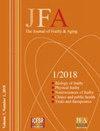Recommendations for Reducing Heterogeneity in Handgrip Strength Protocols
IF 3.3
Q2 GERIATRICS & GERONTOLOGY
引用次数: 11
Abstract
Handgrip dynamometers are widely used to measure handgrip strength (HGS). HGS is a safe and easy to obtain measure of strength capacity, and a reliable assessment of muscle function. Although HGS provides robust prognostic value and utility, several protocol variants exist for HGS in clinical settings and translational research. This lack of methodological consistency could threaten the precision of HGS measurements and limit comparisons between the growing number of studies measuring HGS. Providing awareness of the protocol variants for HGS and making suggestions to reduce the implications of these variants will help to improve methodological consistency. Moreover, leveraging recent advancements in HGS equipment may enable us to use more sophisticated HGS dynamometer technologies to better assess muscle function. This Special Article will 1) highlight differences in HGS protocols and instrumentation, 2) provide recommendations to better specify HGS procedures and equipment, and 3) present future research directions for studies that measure HGS. We also provided a minimum reporting criteria framework to help future research studies avoid underreporting of HGS procedures.减少握把强度协议中异质性的建议
握力计被广泛用于测量握力(HGS)。HGS是一种安全且易于获得的力量能力测量方法,也是一种可靠的肌肉功能评估方法。尽管HGS具有强大的预后价值和实用性,但在临床环境和转化研究中存在几种HGS协议变体。这种方法一致性的缺乏可能会威胁到HGS测量的精度,并限制越来越多的测量HGS的研究之间的比较。提供对HGS协议变体的认识,并提出减少这些变体影响的建议,将有助于提高方法的一致性。此外,利用HGS设备的最新进展可能使我们能够使用更复杂的HGS测功仪技术来更好地评估肌肉功能。这篇专题文章将1)强调HGS协议和仪器的差异,2)提供更好地指定HGS程序和设备的建议,3)提出未来HGS测量研究的研究方向。我们还提供了一个最低报告标准框架,以帮助未来的研究避免少报HGS程序。
本文章由计算机程序翻译,如有差异,请以英文原文为准。
求助全文
约1分钟内获得全文
求助全文
来源期刊

Journal of Frailty & Aging
GERIATRICS & GERONTOLOGY-
CiteScore
5.90
自引率
7.70%
发文量
54
期刊介绍:
The Journal of Frailty & Aging is a peer-reviewed international journal aimed at presenting articles that are related to research in the area of aging and age-related (sub)clinical conditions. In particular, the journal publishes high-quality papers describing and discussing social, biological, and clinical features underlying the onset and development of frailty in older persons. The Journal of Frailty & Aging is composed by five different sections: - Biology of frailty and aging In this section, the journal presents reports from preclinical studies and experiences focused at identifying, describing, and understanding the subclinical pathophysiological mechanisms at the basis of frailty and aging. - Physical frailty and age-related body composition modifications Studies exploring the physical and functional components of frailty are contained in this section. Moreover, since body composition plays a major role in determining physical frailty and, at the same time, represents the most evident feature of the aging process, special attention is given to studies focused on sarcopenia and obesity at older age. - Neurosciences of frailty and aging The section presents results from studies exploring the cognitive and neurological aspects of frailty and age-related conditions. In particular, papers on neurodegenerative conditions of advanced age are welcomed. - Frailty and aging in clinical practice and public health This journal’s section is devoted at presenting studies on clinical issues of frailty and age-related conditions. This multidisciplinary section particularly welcomes reports from clinicians coming from different backgrounds and specialties dealing with the heterogeneous clinical manifestations of advanced age. Moreover, this part of the journal also contains reports on frailty- and age-related social and public health issues. - Clinical trials and therapeutics This final section contains all the manuscripts presenting data on (pharmacological and non-pharmacological) interventions aimed at preventing, delaying, or treating frailty and age-related conditions.The Journal of Frailty & Aging is a quarterly publication of original papers, review articles, case reports, controversies, letters to the Editor, and book reviews. Manuscripts will be evaluated by the editorial staff and, if suitable, by expert reviewers assigned by the editors. The journal particularly welcomes papers by researchers from different backgrounds and specialities who may want to share their views and experiences on the common themes of frailty and aging.The abstracting and indexing of the Journal of Frailty & Aging is covered by MEDLINE (approval by the National Library of Medicine in February 2016).
 求助内容:
求助内容: 应助结果提醒方式:
应助结果提醒方式:


